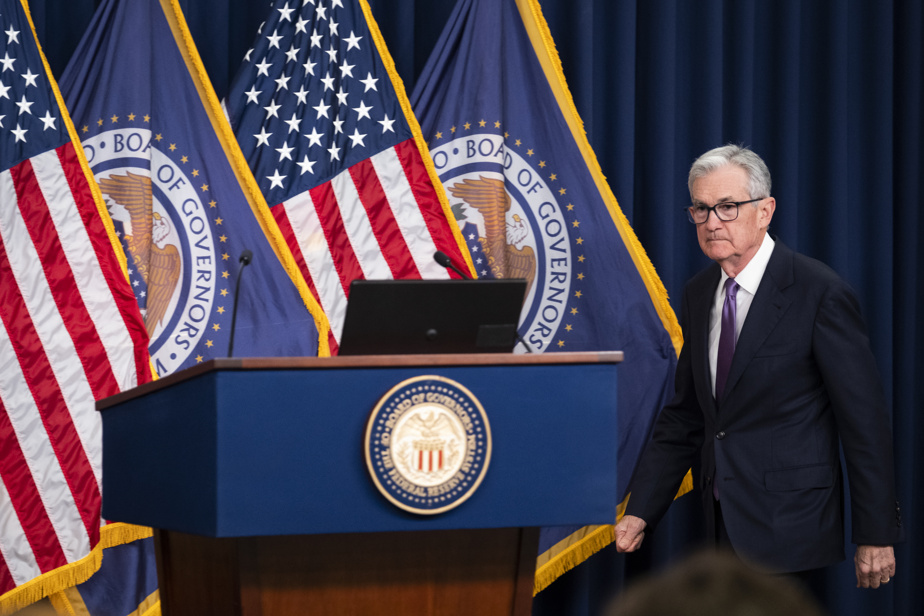(Washington) With a more accommodating and optimistic tone than expected, the American central bank (Fed) welcomed the clear slowdown in inflation on Wednesday at the end of its last meeting of the year, and maintained its rates between 5 .25 and 5.50%.
However, it has not yet won the battle, and the economic trajectory could darken in 2024.
Can the Fed declare victory against inflation?
“Inflation has fallen since its peak, without a significant increase in unemployment. This is very good news,” said Fed President Jerome Powell on Wednesday in the introduction to his press conference. Without boasting: “inflation remains too high”, and “the path is uncertain”.
“President Powell had an optimistic tone,” noted Rubeela Farooqi, chief economist for High Frequency Economics.
Indeed, “inflation has become much lower than what the Fed predicted, opening up new possibilities for 2024,” underlines Krishna Guha, economist for Evercore, an investment consulting company.
From its peak of 9.1% in June 2022, unheard of since the early 1980s, inflation fell to 3.1%, over one year, in November, according to the CPI index.

PHOTO PETE MAROVICH, THE NEW YORK TIMES
Jerome Powell seemed more optimistic on Wednesday, but he judges that inflation “remains too high”.
The enthusiasm of Jerome Powell, usually very cautious, was surprising. He still warned that further rate hikes remained on the table, if necessary.
But Steve Englander, of Standard Chartered, and former economist at the Fed, reports a “more dovish signal than what we or the market expected”.
“The Fed’s change of heart surprised many,” he added, nevertheless raising the hypothesis that with the approach of the American presidential election, the Fed could have wanted to signal an easing of risk. well before the start of the primaries.
What about the hoped-for “soft landing”?
The indicators seem to be in good shape, with inflation on track, a job market which is rebalancing, and vigorous growth. But the Fed warned that “growth in economic activity has slowed,” a necessary condition for a lasting decline in inflation.
“The likelihood that the U.S. economy will enter recession over the next 12 months is higher than usual,” but “by no means guaranteed,” said Gregory Daco, chief economist for EY.
According to him, several difficulties await in 2024: consumer fatigue with high prices, interest rates that are still very high and employment growth which is expected to slow down.
The measures taken by the Fed to slow inflation take months to be felt in the real economy. This is why it has not raised its rates since July, in order to avoid hampering economic activity.
The objective is a soft landing: inflation that falls, and an unemployment rate that remains low.
But it is “possible that this landing ends up being a little more brutal than expected, either because disinflation slows, or because the impact of past rate increases on activity and demand intensifies,” warns William De Vijlder, chief economist for BNP Paribas.
What monetary policy for 2024?
The Fed “abandoned its hawkish stance this week, sending a strong message that rate hikes are over and concerns about risks to the economy […] will play a more important role in future decisions,” notes Nancy Vanden Houten, economist for Oxford Economics.
The Fed anticipates three rate cuts for 2024.
Will they start in May? In June ? Or even as early as March?
“We are aware of the risk if we wait too long,” assured Jerome Powell.
This signals “that the trend is now to reduce rates as soon as possible”, which “marks a change compared to previous procrastination”, deciphers Diane Swonk, chief economist for KPMG.
She anticipates that the Fed will “wait until May, but if the good news continues to arrive as it has, the Fed will make cuts sooner.”
Furthermore, Jerome Powell ruled out any change in trajectory regarding the reduction of the Fed’s balance sheet.
“The only reason to lower rates and simultaneously stop balance sheet reductions would be a serious and sudden deterioration in economic conditions, which is not anticipated,” emphasizes Diane Swonk.
